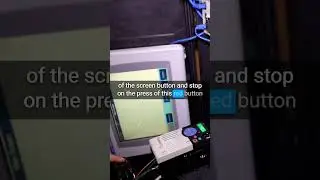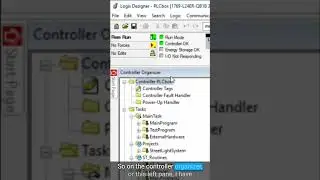Demystifying PLC's Output Enable (OTE) Instruction [OTE - P2]
In this succinct yet insightful YouTube short, the speaker delves into the intricacies of the Output Enable (OTE) instruction within Programmable Logic Controllers (PLCs), shedding light on its functionality and significance within industrial automation processes.
The OTE instruction, as elucidated, plays a pivotal role in facilitating conditional logic within PLC programming. It serves as a gatekeeper, allowing a specific bit to be activated only if all preceding conditional instructions leading up to it evaluate to true. This critical functionality ensures that there is a clear logical path for the system to follow before executing the designated action, thereby enhancing the reliability and precision of automated systems.
Expanding upon the technical nuances, the speaker provides invaluable context by explaining the sequential execution process inherent in PLC operation. PLCs operate in a sequential manner, traversing through the programmed logic from one rung to the next. This sequential execution ensures that each rung is evaluated in order, with the program looping back to the beginning once all rungs have been processed. This insight offers a deeper understanding of how PLCs interpret and execute instructions within industrial automation environments.
Furthermore, the speaker highlights the real-time nature of PLC execution, emphasizing that the OTE instruction is executed every scan time of the PLC. This continuous evaluation ensures rapid responsiveness to changing conditions in the industrial environment, enabling PLCs to adapt dynamically to varying inputs and operational requirements.
In summary, this YouTube short provides a concise yet comprehensive exploration of the Output Enable (OTE) instruction within PLC programming, offering valuable insights into its functionality, execution cycle, and role in driving efficient automation processes. With a blend of clarity and technical depth, the speaker empowers viewers with a deeper understanding of essential concepts in industrial automation and PLC programming.








![Unveiling the Versatility of PLC Output Enable (OTE) Instruction: A Practical Exploration [OTE - P4]](https://images.mixrolikus.cc/video/GIhEopsjQVA)
![Decoding PLC Controller Tags: Navigating Inputs and Logic in Industrial Automation [OTE - P3] #plc](https://images.mixrolikus.cc/video/ZFYO0rCpB0E)
![Demystifying PLC's Output Enable (OTE) Instruction [OTE - P2] #industrial #automation #robotics](https://images.mixrolikus.cc/video/NyMWaXddIdY)
![Green Button vs. Code: Demystifying PLC Magic [OTE - P1] #plc #programming #software #manufacturing](https://images.mixrolikus.cc/video/SHQJoRO7Fv4)




![Ep. 118 - [Travis Cox] Changing Integration Forever - From Integrator to Product and Beyond](https://images.mixrolikus.cc/video/TkYG8Azyz94)
![Ep. 116 - [Dave & Vlad] Automate 2023 Recap - What we Learned, What we Saw & What we Did!](https://images.mixrolikus.cc/video/xQfXB-mQIew)
![Ep. 115 - [Bernd Bergner] Technical Advanced in Industrial Automation from Siemens](https://images.mixrolikus.cc/video/rF96TztC9GE)
![Ep. 114 - [Josef Waltl] Creating Software Automation Tools for the Future](https://images.mixrolikus.cc/video/yQNuiWjrY5M)
![Ep. 113 - [Nick O'Leary] How to Build Open Source Tools for Industrial Applications](https://images.mixrolikus.cc/video/FMirgEzX9TY)
![Programming a Production & Assembly Line Ladder Logic Allen Bradley CompactLogix PLC [Part 10]](https://images.mixrolikus.cc/video/8s6EUjv9BM4)
![Ep. 112 - [Matt Paulissen] Quickly Scale Industrial Applications and Engineering Best-Practices](https://images.mixrolikus.cc/video/Z9-n8fuHc8s)
![Ep. 111 - [Dave & Vlad] Delivering High Impact Solutions Recap & Hannover Messe 2023](https://images.mixrolikus.cc/video/dG6D_ANYHIg)
![Allen Bradley PLC Programming - Implementing Ladder Logic for Machining Center Control [Part 9]](https://images.mixrolikus.cc/video/ikQwF76c3To)
![Ep. 110 - [Rija Rakotoarisoa] Delivering High-Impact Solutions from the Plant Floor](https://images.mixrolikus.cc/video/rQqFgJNU8O0)
![Factory IO Automation System Design - Understanding How to Work with Machine Center [Part 8]](https://images.mixrolikus.cc/video/F0V7MTolaqA)
![Ep. 108 - [Kevin Holbrook] The Impact of ML and AI in Manufacturing!](https://images.mixrolikus.cc/video/Tb_KWG8zYTE)


![Ep. 105 - [Clinton & Russell] How to make your Manufacturing Facility more Sustainable.](https://images.mixrolikus.cc/video/PkSJK9wwGeY)
![Ep. 104.2 - [Francisco Carrión] We're building an Energy Monitoring Solution - Live Online!](https://images.mixrolikus.cc/video/6OUYmLg0PHg)